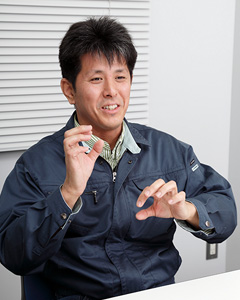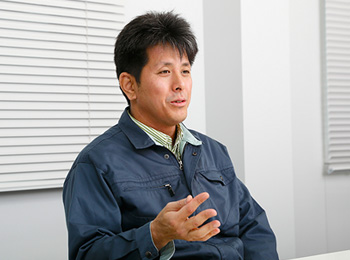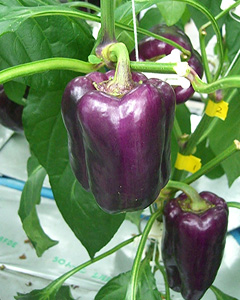

Planned, stable provision of completely pesticide-free vegetables
Greenhouse horticulture in structures made of glass, plastic and other materials has always been a specialized field. I am involved in technological development with the goal of solving problems that occur in the production of tomatoes, strawberries, paprika and bell peppers and other such fruits and vegetables, and I also research growing environment factors such as temperature, humidity and lighting in accordance with growing conditions. As a developmental model, we are currently undertaking research and development for power- and energy-saving urban agricultural production systems at Meiji University’s Advanced Plant Factory Research Center (Department of Agriculture, School of Agriculture) while also conducting research and other activities at the Center’s plant factory in order to promote more widespread use of plant factories.
The use of enclosed, indoor plant factory production environments using artificial light prevents weather from affecting growing operations and enables planned, stable provision of crops. Furthermore, this approach prevents crop damage by insects and infectious agents and enables completely pesticide-free growth for clean produce that can be eaten without washing.
The Center’s plant factory uses only artificial light—it uses no sunlight whatsoever—for the cultivation of crops. The same approach can be utilized for growing in high-rise buildings, empty office space and other urban spaces.
Contributing toward the revitalization of disaster-stricken areas
In recent years, food service corporations and other companies have increasingly utilized in-house plant factories for growing products, transforming the “local production for local consumption” approach into new cultivation models including “store production for store consumption” and even “building production for building consumption.” Because plant factories can produce crops almost exactly according to plan, it is possible to operate factories and produce goods in accordance with orders received—plant factories are especially well-suited for provision of vegetables to food service industry companies and other such corporations. Additionally, CO2 emissions can be scaled down and costs cut during delivery operations if product is grown in urban districts located near target consumption areas.
Associate Professor Ikeda strives to dispel the image of agricultural work as a “3D” (dirty, dangerous and demanding) occupation and make it a production field that appeals to everyone
The challenge of cultivating market appeal
Vegetables produced at plant factories account for less than 1% of all vegetables on the market, which tells us that plant factory vegetables have not yet become widespread. Currently, these factories are mainly being used to grow leafy vegetables with high production efficiencies, and the approach’s weak point can be seen in its low profitability for crops such as rice, wheat, daikon (giant white radish), tomatoes, carrots, cabbage and others with long cultivation times. The further spread of plant factories depends on the expansion of crop types that can be handled.In addition, the lack of widespread understanding among consumers is another obstacle to the further spread of plant factory vegetables. Many people are reluctant to purchase these vegetables because they are not grown using natural sunlight, yet plant factory vegetables actually contain more vitamins, superior textures and other advantages when compared with traditionally grown crops. Furthermore, daikon sprouts, many varieties of mushroom, bean sprouts and other such products have long been grown in plant factories. The reluctance on the part of consumers is a problem of low awareness and emotional response—the fact that many consumers do not know how the vegetables are actually grown is most likely a major contributing factor. From an agricultural and technological perspective, we have already reached the point where full production operations are possible, which means that we must now work to raise awareness among consumers in order to improve these vegetables’ reputation in the market.
Despite the fact that much progress has been made toward increasing energy efficiency in lighting, air conditioning and other such facilities, the key to success for plant factories is the achievement of lower costs, and it is something that we must continue striving to achieve. We must reduce of initial investment costs for necessary facilities and equipment as well as running costs in the form of electricity charges while also exploring ways to firmly establish knowledge on efficient vegetable cultivation methods. In addition, we also need to develop business models in order to increase added value for market products and ensure stable business management. A variety of perspectives are necessary to solve these and other complex problems and establish plant factory businesses, and Meiji University’s Schools of Agriculture, Science and Technology, Commerce, and Business Administration can provide the necessary foundations. We endeavor to utilize interdisciplinary approaches in order to help spread the adoption of plant factories, taking consideration of various perspectives including cultivation of know-how, equipment optimization, sales and management strategies and others.
Significance in terms of food security

Associate Professor Ikeda is personally interested in the purple paprika, which is the same color as Meiji University’s school colors—he is quietly planning a related branding strategy.
Plant factories are also a necessity when food security is taken into consideration: it is possible that, in the future, imported food prices will skyrocket due to the rapid onset of irregular weather patterns, or that food product imports will be cut off for some reason. Therefore, it is important to establish numerous procurement options as a safety net of sorts in preparation for such situations.
A Japanese astronaut has recently completed, an extended stay mission in a space station orbiting the earth. In the future, it is likely that human beings residing in space will require plant factories for food supply purposes. We plan to continue our research in this area and others within the field of agriculture, an area that holds much promise.
Profile
Associate Professor, Department of Agriculture, School of AgricultureAfter working at Ministry of Agriculture, Forestry and Fisheries testing and research facilities, Takashi Ikeda joined Meiji University in 2006 as an associate professor and became the director of the Meiji University Advanced Plant Factory Research Center in 2012. He has a Ph.D. in agriculture from Ehime University.
Production systems, horticulture, instrumentation engineering
Shokumotsu Kojo—Seisan Shokubutsu no Sentei no Tame no Kosatu (“Plant Factories: An Examining of Production Vegetable Selection,” Johokiko); Shokubutsu Kojo Taizen (“A Complete Work on Plant Factories,” joint authorship, Nikkei Business Publications); Tesuto no Hanamichi TV appearance (NHK Educational TV); Tokoton Hatena TV appearance (TV Tokyo); other appearances in the news, on the radio, in the Nihon Keizai Shimbun and Japan Agricultural News newspapers, etc.









